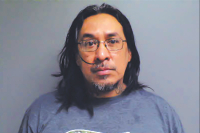The mysterious art of dowsing
By Julia Merchant • Staff Writer
Searching for the term “dowsing” on the Internet will bring up all kinds of Web sites related to the paranormal. But to many who practice the craft, including Alvin Fradey, dowsing is simply an unexplained technique that works and can help locate everything from skeletons to minerals. It was first used to find underground water sources.
Fradey said the method was passed down to him from his grandmother, a native of the Appalachian region. Dr. Tyler Blethen, a professor at Western Carolina University who specializes in Appalachian Studies, explained that the practice of dowsing “goes way back into European history,” and was most likely brought over here by settlers from that area.
Though often done using a forked rod, Fradey uses two separate copper rods to dowse. As he walks over a gravesite going east to west, the rods appear to cross over one another. When Fradey is no longer over the grave, the rods uncross.
The technique varies from dowser to dowser. Mack Sutton, a local resident who has helped document cemeteries in Jackson, Swain and Macon counties, learned the technique from a man in Maryville, Tenn., in 1996. Sutton uses brass instruments instead of copper, and says he can determine the gender of the body in the grave by the way his rods point.
Neither of the dowsers was able to give an explanation as to why dowsing works. Fradey said one scientific theory he has heard is that the body turns into carbon oxidized matter when it decays, causing it to magnetize and have an effect on objects with magnetic properties, like copper. But Fradey is no scientist by training. Deep down, his belief is that “you have to be a native of this land and really believe in what you’re doing.”
That seems to be the common feeling about dowsing held by many in the Appalachian region.
“I think it’s thought of more in terms of a gift that some people have — I doubt many would think of it as being supernatural,” Blethen said.
It should be noted that dowsing is not accepted as valid by the scientific community.
“It’s very much like other kinds of pseudoscience. It’s the person causing it to happen,” said Ken Taylor, chief geologist for the North Carolina Geological Survey.
Taylor added that dowsing has not held up to scientific testing and could be easily manipulated by the dowser. He offered up a couple of ways that dowsers could actually be locating graves. Dirt looks different after it is dug up and replanted, and a dowser that locates one grave could establish a pattern that would help him or her guess where the others might be.
Dowsers don’t seem fazed by the doubters.
“There’s still a significant number of people who believe in it and swear by it,” said Blethen.





